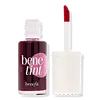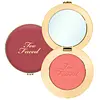What's inside
What's inside
 Key Ingredients
Key Ingredients

 Benefits
Benefits

 Concerns
Concerns

 Ingredients Side-by-side
Ingredients Side-by-side

Mica
Cosmetic ColorantAlumina
AbrasiveZinc Stearate
Cosmetic ColorantCaprylic/Capric Triglyceride
MaskingOctyldodecyl Stearoyl Stearate
EmollientMethylpropanediol
SolventCaprylyl Glycol
EmollientGlycerin
HumectantIris Florentina Root Extract
MaskingLeuconostoc/Radish Root Ferment Filtrate
AntimicrobialRetinyl Palmitate
Skin ConditioningPhenylpropanol
MaskingZinc Sulfate
AntimicrobialKaolin
AbrasiveParfum
MaskingCoumarin
PerfumingSodium Dehydroacetate
PreservativeCI 77891
Cosmetic ColorantCI 77491
Cosmetic ColorantCI 77492
Cosmetic ColorantCI 77499
Cosmetic ColorantCI 42090
Cosmetic ColorantCI 45410
Cosmetic ColorantCI 15850
Cosmetic ColorantCI 77007
Cosmetic ColorantCI 19140
Cosmetic ColorantMica, Alumina, Zinc Stearate, Caprylic/Capric Triglyceride, Octyldodecyl Stearoyl Stearate, Methylpropanediol, Caprylyl Glycol, Glycerin, Iris Florentina Root Extract, Leuconostoc/Radish Root Ferment Filtrate, Retinyl Palmitate, Phenylpropanol, Zinc Sulfate, Kaolin, Parfum, Coumarin, Sodium Dehydroacetate, CI 77891, CI 77491, CI 77492, CI 77499, CI 42090, CI 45410, CI 15850, CI 77007, CI 19140
 Reviews
Reviews

Alternatives
Ingredients Explained
These ingredients are found in both products.
Ingredients higher up in an ingredient list are typically present in a larger amount.
Parfum is a catch-all term for an ingredient or more that is used to give a scent to products.
Also called "fragrance", this ingredient can be a blend of hundreds of chemicals or plant oils. This means every product with "fragrance" or "parfum" in the ingredients list is a different mixture.
For instance, Habanolide is a proprietary trade name for a specific aroma chemical. When used as a fragrance ingredient in cosmetics, most aroma chemicals fall under the broad labeling category of “FRAGRANCE” or “PARFUM” according to EU and US regulations.
The term 'parfum' or 'fragrance' is not regulated in many countries. In many cases, it is up to the brand to define this term.
For instance, many brands choose to label themselves as "fragrance-free" because they are not using synthetic fragrances. However, their products may still contain ingredients such as essential oils that are considered a fragrance by INCI standards.
One example is Calendula flower extract. Calendula is an essential oil that still imparts a scent or 'fragrance'.
Depending on the blend, the ingredients in the mixture can cause allergies and sensitivities on the skin. Some ingredients that are known EU allergens include linalool and citronellol.
Parfum can also be used to mask or cover an unpleasant scent.
The bottom line is: not all fragrances/parfum/ingredients are created equally. If you are worried about fragrances, we recommend taking a closer look at an ingredient. And of course, we always recommend speaking with a professional.
Learn more about Parfum